
Hold geometrii vzdávají v jedné výstavě Vladislav Mirvald a Jan Kaláb Paying tribute to geometry in an exhibition are Vladislav Mirvald and Jan Kaláb
Prague – Fascination with geometry connects two artists who have never met, but Galerie Villa Pellé in Prague 6 has prepared a joint exhibition for them. The exhibition Code of Geometry brings together the somewhat overlooked but original creator from Louny, Vladislav Mirvald, with the dynamic world of graffiti and street-art master Jan Kaláb. The exhibition will be open until September 26.
Kaláb personally encounters Mirvald's work at the exhibition for the first time. "I decided to approach this exhibition conceptually as a reaction to the work of Vladislav Mirvald. I reduced my palette to white, black, red, and blue. This forced me to focus more on shape and dynamics by emphasizing the maximum contrast of two colors," Kaláb described his approach to the exhibition.
According to the exhibition curator Martina Vítková, geometry is a language understood across continents and cultures. Geometric shapes are a key component of many scientific disciplines, but they also carry spiritual and mystical symbolism. A point represents an individual, a circle symbolizes the sun, a square represents the earth, and a triangle personifies divine power. Geometry has been an important expressive tool in visual art from antiquity to modernity.
"The idea to jointly organize an exhibition of Vladislav Mirvald was proposed to me by the Kampa Museum more than a year ago, and during discussions about its form, the idea emerged to invite one of the contemporary artists who has a close relationship with geometric vision of the world. Jan Kaláb was an obvious choice for me," said the director of Galerie Villa Pellé, Vladana Rýdlová. According to her, Kaláb, as an artist, is not afraid of experiments and makes extensive use of all contemporary technologies that were not available during Mirvald's lifetime.
Vladislav Mirvald (1921 to 2003) studied art education and descriptive geometry at Charles University. He belonged to a generation of artists who began creating in the 1940s, linking back to progressive movements of the early 20th century. Mirvald primarily focused on cubism, developing its principles in intimately toned paintings. In the 1950s, he devoted himself to landscapes, and in the early 1960s, he gradually turned towards abstraction, expressing reality in increasingly simpler hints.
He began to develop several lines of his own artistic language. He incorporated chance into his artwork. His technique of "kankážení," for example, is well-known, where he added ink to a watercolor layer on paper with a brush. He transformed natural laws and processes into pictorial compositions. Mirvald's mature work includes lettrism, which played with lettering on canvas, combinatorial art, or distinctive variants of op art, a movement that works with elements of optical effects.
Kaláb (1978) graduated from the Academy of Fine Arts and was already a well-known graffiti artist at that time. He is a co-founder of the exhibition space Trafačka. He has left his mark on walls and trains in many metropolises. Currently, among other works, he creates paintings in which entrances and tunnels to other dimensions and circular shapes play an important role, intensifying space to resemble a dark matter emitting an incredibly dense energy. In his latest series of paintings, he works with blue-red-white-black colors, responding to Mirvald's painting Tribute to the Republic from July 1968.
Kaláb personally encounters Mirvald's work at the exhibition for the first time. "I decided to approach this exhibition conceptually as a reaction to the work of Vladislav Mirvald. I reduced my palette to white, black, red, and blue. This forced me to focus more on shape and dynamics by emphasizing the maximum contrast of two colors," Kaláb described his approach to the exhibition.
According to the exhibition curator Martina Vítková, geometry is a language understood across continents and cultures. Geometric shapes are a key component of many scientific disciplines, but they also carry spiritual and mystical symbolism. A point represents an individual, a circle symbolizes the sun, a square represents the earth, and a triangle personifies divine power. Geometry has been an important expressive tool in visual art from antiquity to modernity.
"The idea to jointly organize an exhibition of Vladislav Mirvald was proposed to me by the Kampa Museum more than a year ago, and during discussions about its form, the idea emerged to invite one of the contemporary artists who has a close relationship with geometric vision of the world. Jan Kaláb was an obvious choice for me," said the director of Galerie Villa Pellé, Vladana Rýdlová. According to her, Kaláb, as an artist, is not afraid of experiments and makes extensive use of all contemporary technologies that were not available during Mirvald's lifetime.
Vladislav Mirvald (1921 to 2003) studied art education and descriptive geometry at Charles University. He belonged to a generation of artists who began creating in the 1940s, linking back to progressive movements of the early 20th century. Mirvald primarily focused on cubism, developing its principles in intimately toned paintings. In the 1950s, he devoted himself to landscapes, and in the early 1960s, he gradually turned towards abstraction, expressing reality in increasingly simpler hints.
He began to develop several lines of his own artistic language. He incorporated chance into his artwork. His technique of "kankážení," for example, is well-known, where he added ink to a watercolor layer on paper with a brush. He transformed natural laws and processes into pictorial compositions. Mirvald's mature work includes lettrism, which played with lettering on canvas, combinatorial art, or distinctive variants of op art, a movement that works with elements of optical effects.
Kaláb (1978) graduated from the Academy of Fine Arts and was already a well-known graffiti artist at that time. He is a co-founder of the exhibition space Trafačka. He has left his mark on walls and trains in many metropolises. Currently, among other works, he creates paintings in which entrances and tunnels to other dimensions and circular shapes play an important role, intensifying space to resemble a dark matter emitting an incredibly dense energy. In his latest series of paintings, he works with blue-red-white-black colors, responding to Mirvald's painting Tribute to the Republic from July 1968.
The English translation is powered by AI tool. Switch to Czech to view the original text source.
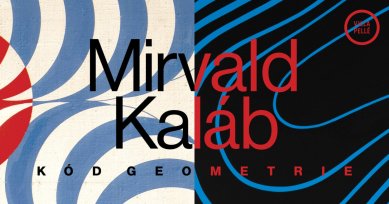
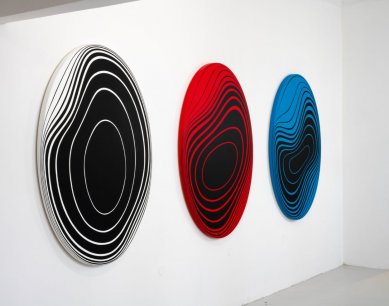
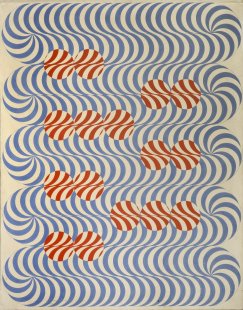
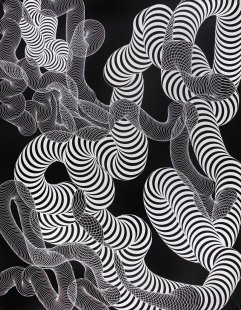
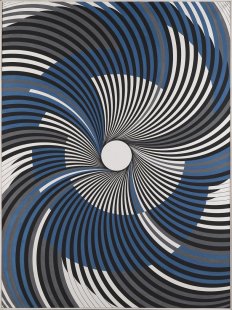
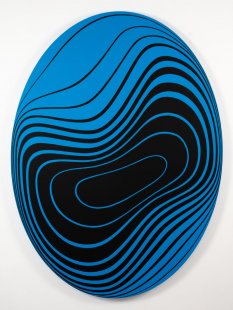
0 comments
add comment









